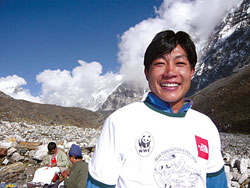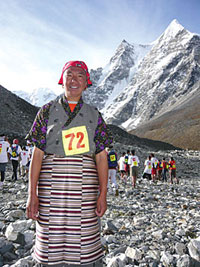 |
Nations also say the same thing. Small countries are having to suffer for the sins of others. They face a disproportionate share of the punishment for the big, rich and powerful nations burning all that fossil fuel. And they say, let the rich countries do something to curb emissions, it's not our problem. They say: "No matter what we do, the seas will keep rising, the glaciers will keep melting."
I used to think the same way until I participated in the Imja Action Run, the 35km marathon on 18 July. Imja is the glacier below Chomolungma where the melting glacier has created a lake 2km long and 500m wide where there was just snow and ice 50 years ago. The length of the lake is growing at 75m every year.
 ROB SANDERSON That's me with the northwest face of Ama Dablam in the background. |
Across the Hindu Kush-Himalayan region, there are more than 9,000 glacial lakes, including 200 potentially dangerous ones like Imja. They have been formed because of the earth's warming trend since the last ice age that has been accelerating because of man-made emissions of greenhouse gases into the atmosphere in the post-industrial age.
Almost two months have passed since the Imja Action Run, and I have been thinking about what it meant for me personally and what it achieved in spreading awareness about the melting of the Himalayan mountains.
The marathon was called 'Beat the GLOF Imja Action Run' and was organised by the Kathmandu-based NGO, iDEAS, and local youths in Khumbu. GLOF is an acronym for Glacial Lake Outburst Flood, which is what happens when a glacial lake gorged with melting ice bursts and unleashes a tsunami in the valley below.
Glaciologists say there is a GLOF in Himalayan region every 3-10 years. GLOFs can cause huge damage not only to the settlements and inhabitants, but also to roads, bridges and power plants built along the rivers.
 Participants gather at the Imja Tso the day before the marathon. |
For long stretches of the marathon, we were running along the Imja Khola, the route of a possible future GLOF and we could see the trails, bridges and settlements that would be directly in the path of the wall of mud, boulders and water that would come crashing down if the Imja Lake burst. Actually, it isn't a question of "if", but "when".
The world famous trekking route to Everest Base Camp would be washed away by the massive debris flow. The water would reach Dingboche, the first settlement below Imja Lake, in 14 minutes and the village would be swallowed up.
Thankfully, Tengboche and Namche will be spared, but the flood would reach Lukla in one hour, destroying everything on its path. On 4 August 1985, the Dig Tso GLOF and another one on the Imja Khola a few years later caused huge damage in the Khumbu, so the phenomenon is not new.
 |
A day before the run we climbed the moraine wall to look at Imja Lake. I was shocked, it was huge, really huge: much larger than I had ever imagined it to be. To think that all this water and sand and boulders could go crashing down the narrow valleys below was unthinkable.
Soon after starting the run, I was gasping at the thin air. My lungs were working like they'd never worked before, my heart was pounding so hard I could hear it as I ran. I wanted to give up, but passion for the cause kept me going. And with every step that took me down the mountain, the air became thicker and sweeter.
I was greeted warmly by village children who ran along with me. I got to Khumjung in 6 hours 58 minutes, behind most of the Nepali runners. This wasn't a race, and the important thing was to have participated.And as I crossed the finishing line, a deep feeling of fulfillment came over me, for having proved to myself that I could do it. And also a feeling that I had at least done my bit to raise awareness about this global crisis.
 MIKI UPRETI |
This meeting could very well be another one of those talk-fests where ministers generate a lot of carbon dioxide to travel long distances to deliver long speeches. But my mind will be far away on the wind-swept moraine ridge looking down at Imja Lake, pondering if we will indeed act before it is
too late.
We will also be forced to ask ourselves, what can we
do to act as individuals or as nations to do something on our own?
Miki Upreti is a journalist, mountaineer and runner who is originally from Japan and has been living in Kathmandu since 1990.


